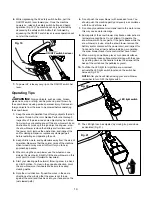
2
Safety WARNINGS!
When Using Electric Mode
•
Electrical plugs must match the outlet. Never modify
the plug in any way. Do not use any adapter plugs with
grounded appliances. Unmodified plugs and matching
outlets will reduce the risk of electric shock.
•
Avoid body contact with earthed or grounded surfaces
(i.e. upper and lower water pipes, radiators, ranges,
refrigerators, microwave ovens, and outer frames of heating
equipment). Take necessary precautions to avoid electric
shock. There is an increased risk of electric shock if your
body is earthed or grounded.
•
Do not abuse the cord.
Keep the cord away from heat,
oil, sharp edges, or moving parts. Never carry the snow
blower by its cord or yank the cord to disconnect it from the
electrical outlet. Damaged or entangled cords increase the
risk of electric shock.
•
Replace or properly repair damaged cords. If the cord
becomes damaged in any manner while plugged into the
wall receptacle, immediately unplug the extension cord plug
from the receptacle.
•
Contact with water while operating the snow blower
can result in electric shock and serious bodily injury.
Do not use the snow blower in damp or wet locations or
expose to rain. Do not handle the plug or the appliance with
wet hands or while standing in water.
•
m
WARNING – Use outdoor extension cords marked
SW-A, SOW-A, STW-A, STOW-A, SJW-A, SJTW-A, or
SJTOWA. These cords are rated for outdoor use and
reduce the risk of electric shock.
• If you find the main power cable or the extension cable
damaged, immediately unplug the cable from the socket
and disconnect the power immediately. Repair the cable
or replace it if necessary.
•
Do not move or transport the snow blower when the
plug is connected to the power socket and the switch is
turned on.
B Charger
Safety Instructions
We pay a great deal of attention to the design of every battery
pack to ensure that we supply you with batteries that are safe,
durable and have a high energy density. The battery cells have
a wide range of safety devices. Each individual cell is initially
formatted and its electrical characteristic curves are recorded.
This data is then used exclusively to be able to assemble the
best possible battery packs.
Despite all the safety precautions, caution must always be
exercised when handling batteries. The following points must
be obeyed at all times to ensure safe use. Safe use can only
be guaranteed if undamaged cells are used. Incorrect handling
of the battery pack can cause cell damage.
IMPORTANT!
Analyses confirm that incorrect use and poor
care of high-performance batteries are the main factors
responsible for personal and/or product damage.
m
WARNING!
Use only approved replacement batteries;
other batteries may damage the hybrid snow blower and
cause it to malfunction, which can lead to serious personal
injury.
m
CAUTION!
To reduce the risk of injury, charge the
EcoSharp
®
iBAT40 lithium-ion battery pack only in its
designated lithium-ion charger, the iCHRG40. Other types of
chargers present risk of fire, personal injury and damage. Do
not wire a battery pack to a power supply plug or car cigarette
lighter. Such misuse will permanently disable or damage the
battery pack.
•
Avoid dangerous environments – Do not charge the
battery pack in rain, snow or in damp or wet locations.
Do not use the battery pack or charger in the presence of
explosive atmospheres (gaseous fumes, dust or flammable
materials) because sparks may be generated when inserting
or removing the battery pack, which could lead to a fire.
•
Charge in a well-ventilated area – Do not block the
charger vents. Keep them clear to allow for proper
ventilation. Do not allow smoking or open flames near a
charging battery pack. Vented gases may explode.
NOTE: The safe temperature range for the battery is -4°F
(-20°C) to 113°F (45°C). Do not charge the battery outside
in freezing weather; charge it at room temperature.
•
Maintain charger cord –
When unplugging the charger, pull
the plug, not the cord, from the receptacle to reduce the
risk of damage to the electrical plug and cord. Never carry
the charger by its cord or yank it by the cord to disconnect
it from the receptacle. Keep the cord away from heat, oil
and sharp edges. Make sure the cord will not be stepped
on, tripped over or subjected to damage or stress when the
charger is in use. Do not use the charger with a damaged
cord or plug. Replace a damaged charger immediately.
•
Do not use an extension cord unless it is absolutely
necessary –
Using the wrong, damaged or improperly
wired extension cord poses a risk of fire and electric shock.
If an extension cord must be used, plug the charger into a
properly wired 16 gauge or larger extension cord with the
female plug matching the male plug on the charger. Make
sure that the extension cord is in good electrical condition.
•
Charger iCHRG40 is rated for 120 volt AC only – The
charger must be plugged into an appropriate receptacle.
•
Use only recommended attachments – Use of an
attachment not recommended or sold by the battery
charger or battery pack manufacturer may result in risk of
fire, electric shock or personal injury.
•
Unplug charger when not in use – Make sure to remove
battery packs from unplugged chargers.
Summary of Contents for iON18SB-HYB
Page 20: ...snowjoe com...



































